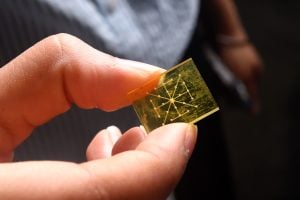
Chronic stress affects nearly every part of the human body, yet scientists still struggle to track its full impact. A key challenge is the difficulty of measuring cortisol—the body’s main stress hormone—outside of clinical settings, despite its key role in regulating blood pressure, sleep, the immune system, and more.
A team of engineering students aims to change that with CortiTrack, a wearable biosensor that continuously monitors cortisol in real time, offering a clearer picture of how levels ebb and flow throughout a day. They presented their project on April 29 at the Whiting School of Engineering’s Design Day, an annual event showcasing students’ innovation and ability to translate theoretical knowledge into real-world solutions.
“Long-term cortisol imbalances, whether too high or too low, can lead to issues like anxiety, fatigue, heart problems, and more,” said chemical and biomolecular engineering team member Nishtaa Modi, who developed the project with electrical and computer engineering student Kevin Toralez, data science student Sukriti Gupta, and biomedical engineering student Riya Gupta. “Cortisol levels also affect the immune system and sleep patterns.”
Currently, cortisol levels are typically measured through blood or urine samples, which offer a single snapshot in time.
“They don’t capture how cortisol fluctuates throughout the day,” says Toralez.

CortiTrack uses a painless, minimally invasive patch, with microscopic needles that penetrate less than 1mm beneath the skin’s surface to extract interstitial fluid—the clear liquid surrounding the body’s cells. The patch is designed for long-term wear, with the microneedles continuously extracting interstitial fluid for real-time monitoring. While the patch itself can stay in place, the sensor cartridges are easily replaceable daily to maintain accuracy and performance.
“The device relies on an electroactive molecularly imprinted polymer material that can selectively detect cortisol,” says Gupta. The system generates an electrical signal that reflects the hormone’s concentration, which is then read by a custom circuit board and sent to a mobile app via Bluetooth.
Once in the app, the data could be shared with a doctor to help track stress patterns over time. In an ideal scenario, a physician might use this information to recommend lifestyle changes, therapy, or medications that help regulate stress-related conditions.
Currently, the team is working on a shoebox-sized prototype to validate the system’s components. Building CortiTrack has involved a multidisciplinary effort across polymer chemistry, electronics, and microfluidics, and one of the team’s biggest challenges has been sourcing materials and coordinating manufacturing.
“Our biggest hurdle was finding manufacturing partners who could help us in our prototyping journey,” says Gupta.
After a global search, they secured key partnerships with a lab in India for the polymer sensors and a company in Taiwan for the device hardware.
Once they have tested and validated their prototype, the team plans to develop a market-ready version capable of continuous, real-time cortisol tracking.
“By tracking cortisol in real time, we hope to give individuals and clinicians a better tool for understanding how stress develops and changes throughout the day,” said Modi. “It’s a step toward making stress monitoring more precise and actionable.”